Cities of the Future
 Bashny.Net
Bashny.Net
What should be the city of the future? In the first place it should solve the problems of overpopulation, pollution and development by creating a dense vertical buildings, which are interconnected at all levels. Residents will be able to move freely from one place to another on foot. Here conceptual twelve cities, some of which are already under construction. They are based on free movement, which sometimes goes so far that the cars are not needed.
A city without cars
1. China is creating a city without a car from scratch, building the town center around the residential nucleus, which fits 80,000 people. Great City (Big City) should appear in the countryside outside of Chengdu. He is completely pedestrian and green. From the center to the outer ring of parks can be reached on foot in less than ten minutes. Other nearest urban centers will be accessible through public transportation. City would use 48% less power and 58% less water than other conventional city of the same size and will produce 89% less waste.

City Without carbon
2. The greenest metropolis in the world - without cars and skyscrapers - is now being built in the desert outside Abu Dhabi. Masdar, the world's first city with zero carbon emissions and waste, will work on the system of public high-speed transport instead of personal cars and depend on solar, wind and geothermal energy. Giant "cap sunflowers" provide a movable shade during the day, will keep the heat and release it at night.
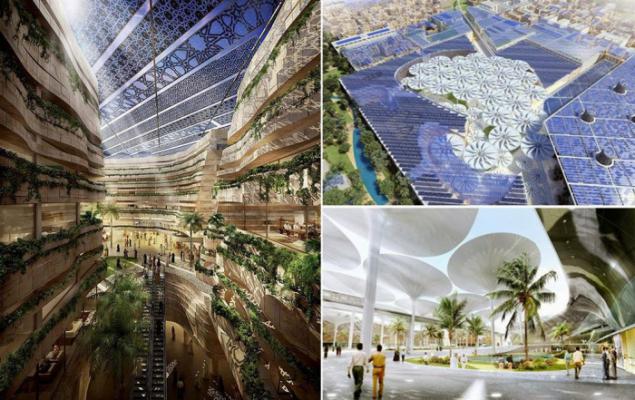
City Lawn
3. MAD Architects sees in the city Shang Sui city of the future. The concept is based on the worship of mountains and water in China, so the concept consists of a large-scale mixed-use buildings with a large number of public places where people can gather, socialize and enjoy nature. Densely populated leads to the fact that all necessary resources are easily accessible within an easy walk or movement of public transport. Architects say that the high density of life is much more stable as an idea in the construction of the city than the current trend of "boxes take over the world." At the heart of this concept is also easy access to nature, as well as to schools, places of work and public health.

Green City in the desert
4. Baharash Architecture proposes to include in Dubai "best practices in environmental construction", focusing on public relations and social interaction on the background of greenery. The structure consists of 550 villas, organic farms, educational institutions and 200 000 square meters of solar panels. The city will be self-produce 50% of the necessary energy and compensate for its carbon emissions at the expense of public transport.

Green Gothenburg future
5. Breakfast Gothenburg can be even greener, according Kjellgren Kaminsky Architecture. Ultra Heavy construction make Gothenburg self-sufficient as regards energy and food. The rooftop windmills for growing food, and solar panels to generate electricity. Heavy construction reduces road traffic and the river becomes more meaningful means of transport.

Vertical City
6. "Melbourne is not growing, and growing up and down" - say in John Wardle Architects about their concept of Multiplicity, in which Australian city is represented in a hundred years. "New ways of aerial and underground city open up entirely new perspectives. Aircraft and urban topography allow in the future to collect food, rain water and energy from new sources ».
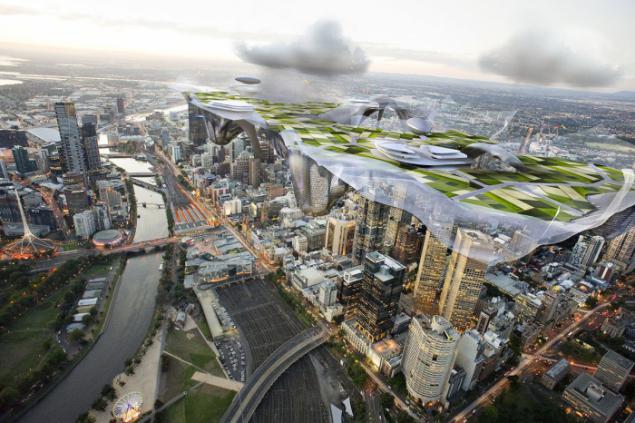
City pedestrians
7. The entire city of San Juan in Puerto Rico is subject to transformation by 1, 5 billion dollars, and becomes a "city walks" with the new system of public transport. It is the largest and very controversial change. In the city vehicles are prohibited. San Juan suffering from population decline in 60 years, and the authorities want to attract new people, charmed them a pedestrian zone in the heart of the city, where pedestrians do not have to worry about cars or inhale exhaust fumes. The beautiful beaches of the city are now inaccessible due to the ports and over-reliance on cars.
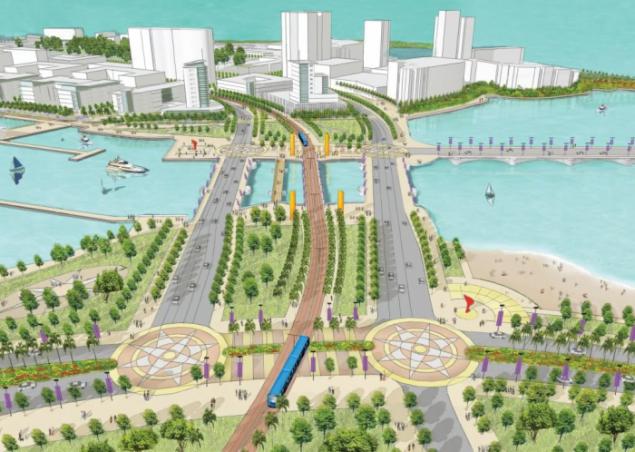
City center comfort with
8. The winning design in the competition ReThink Athens (Rethink Athens) from the heart of OKRA turns into a bright, green and accessible to pedestrians, not cars Center. Green areas provide shade and shelter, mitigate the heat, encouraging a more active holiday. The new green avenues also provide flotation to all surrounding areas.
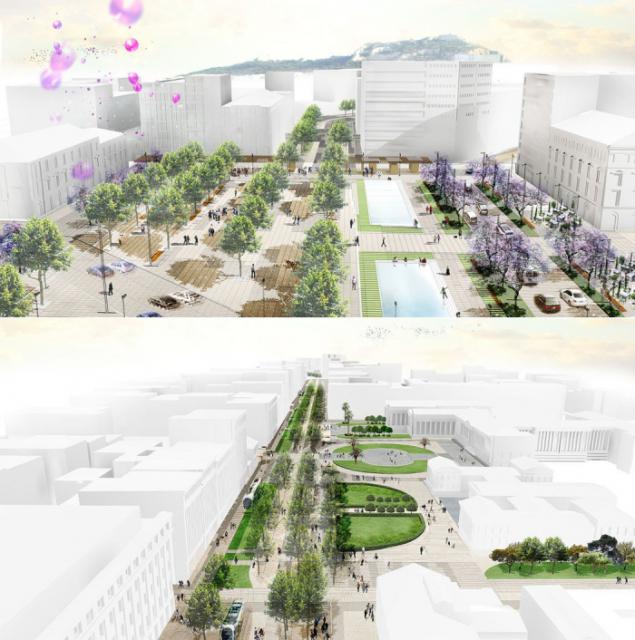
Floating City
9. Haiti is an island nation, ravaged by poverty and natural disasters, like the earthquake that leveled much of Port-au-Prince to the ground and left millions of people homeless. The architect E. Kevin Schopfer introduced a new floating city 30 000 inhabitants in the immediate vicinity of the coast and the living area, supporting agriculture and light industry. 3-km diameter complex consists of four quarters in the form of floating modules, interconnected system of linear channels. Able to withstand hurricanes and typhoons, the city could be extended if necessary.

Three-dimensional city
10. What if our cities were the same as if our architects worked with a three-dimensional grid? The idea belongs to the competition eVolo 2011 Skyscraper Competition called NeoTax. Structures that are growing up and on. Arranged in the horizontal and vertical grid of streets, buildings are based on a modular system, where each module can be considered as a separate building connected to the other on the ground level. Roughly speaking, we are all neighbors and we will not be uprooted for the construction of green spaces.
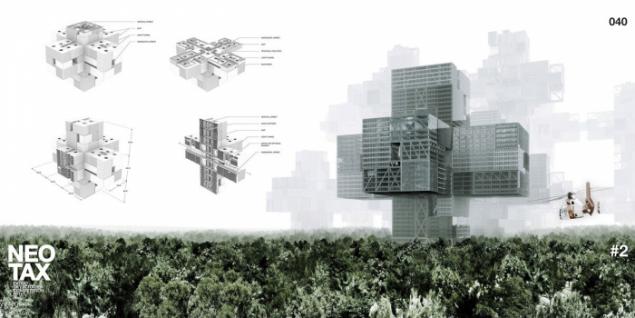
City of "stones»
11. The Belgian architect Vincent Callebaut is known for its design, which draws inspiration from natural forms, such as floating cities in the form of a lotus. This time, he presented a vertical city Shenchzhen in China, made in the form of Carney, or stone pyramids. "The challenge in creating a favorable urban environment with zero carbon emissions and positive energy," - says the architect. In this project the city should live by the laws of the jungle, and have to be high-density orchards and vegetable gardens, arranged directly in the residential towers. Each tower contains 20 glazed "pebbles", covered with solar panels and wind turbines.
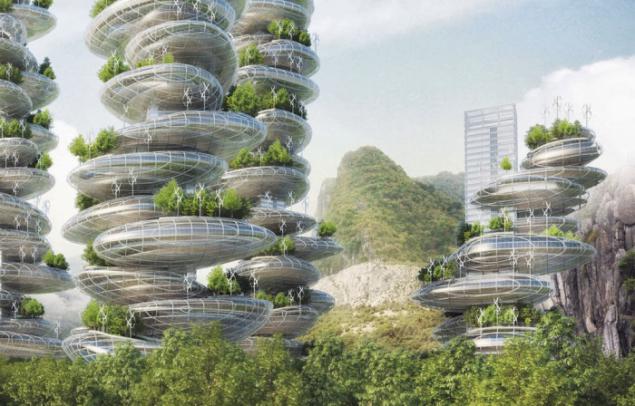
The city, free from fear
12. What is it - live in the city, free from fear? This concept was created for the Now + When, Australian Urbanism Exhibition in 2010, and focuses on the things that make people free from fear, and not oppress them in modern cities. For this purpose, the city should be built such lattice streets and spaces that emphasize the relationship and movement. Visible links connecting the various buildings and surroundings at all levels of the city, would allow citizens to feel more open.

©
A city without cars
1. China is creating a city without a car from scratch, building the town center around the residential nucleus, which fits 80,000 people. Great City (Big City) should appear in the countryside outside of Chengdu. He is completely pedestrian and green. From the center to the outer ring of parks can be reached on foot in less than ten minutes. Other nearest urban centers will be accessible through public transportation. City would use 48% less power and 58% less water than other conventional city of the same size and will produce 89% less waste.

City Without carbon
2. The greenest metropolis in the world - without cars and skyscrapers - is now being built in the desert outside Abu Dhabi. Masdar, the world's first city with zero carbon emissions and waste, will work on the system of public high-speed transport instead of personal cars and depend on solar, wind and geothermal energy. Giant "cap sunflowers" provide a movable shade during the day, will keep the heat and release it at night.

City Lawn
3. MAD Architects sees in the city Shang Sui city of the future. The concept is based on the worship of mountains and water in China, so the concept consists of a large-scale mixed-use buildings with a large number of public places where people can gather, socialize and enjoy nature. Densely populated leads to the fact that all necessary resources are easily accessible within an easy walk or movement of public transport. Architects say that the high density of life is much more stable as an idea in the construction of the city than the current trend of "boxes take over the world." At the heart of this concept is also easy access to nature, as well as to schools, places of work and public health.

Green City in the desert
4. Baharash Architecture proposes to include in Dubai "best practices in environmental construction", focusing on public relations and social interaction on the background of greenery. The structure consists of 550 villas, organic farms, educational institutions and 200 000 square meters of solar panels. The city will be self-produce 50% of the necessary energy and compensate for its carbon emissions at the expense of public transport.

Green Gothenburg future
5. Breakfast Gothenburg can be even greener, according Kjellgren Kaminsky Architecture. Ultra Heavy construction make Gothenburg self-sufficient as regards energy and food. The rooftop windmills for growing food, and solar panels to generate electricity. Heavy construction reduces road traffic and the river becomes more meaningful means of transport.

Vertical City
6. "Melbourne is not growing, and growing up and down" - say in John Wardle Architects about their concept of Multiplicity, in which Australian city is represented in a hundred years. "New ways of aerial and underground city open up entirely new perspectives. Aircraft and urban topography allow in the future to collect food, rain water and energy from new sources ».

City pedestrians
7. The entire city of San Juan in Puerto Rico is subject to transformation by 1, 5 billion dollars, and becomes a "city walks" with the new system of public transport. It is the largest and very controversial change. In the city vehicles are prohibited. San Juan suffering from population decline in 60 years, and the authorities want to attract new people, charmed them a pedestrian zone in the heart of the city, where pedestrians do not have to worry about cars or inhale exhaust fumes. The beautiful beaches of the city are now inaccessible due to the ports and over-reliance on cars.

City center comfort with
8. The winning design in the competition ReThink Athens (Rethink Athens) from the heart of OKRA turns into a bright, green and accessible to pedestrians, not cars Center. Green areas provide shade and shelter, mitigate the heat, encouraging a more active holiday. The new green avenues also provide flotation to all surrounding areas.

Floating City
9. Haiti is an island nation, ravaged by poverty and natural disasters, like the earthquake that leveled much of Port-au-Prince to the ground and left millions of people homeless. The architect E. Kevin Schopfer introduced a new floating city 30 000 inhabitants in the immediate vicinity of the coast and the living area, supporting agriculture and light industry. 3-km diameter complex consists of four quarters in the form of floating modules, interconnected system of linear channels. Able to withstand hurricanes and typhoons, the city could be extended if necessary.

Three-dimensional city
10. What if our cities were the same as if our architects worked with a three-dimensional grid? The idea belongs to the competition eVolo 2011 Skyscraper Competition called NeoTax. Structures that are growing up and on. Arranged in the horizontal and vertical grid of streets, buildings are based on a modular system, where each module can be considered as a separate building connected to the other on the ground level. Roughly speaking, we are all neighbors and we will not be uprooted for the construction of green spaces.

City of "stones»
11. The Belgian architect Vincent Callebaut is known for its design, which draws inspiration from natural forms, such as floating cities in the form of a lotus. This time, he presented a vertical city Shenchzhen in China, made in the form of Carney, or stone pyramids. "The challenge in creating a favorable urban environment with zero carbon emissions and positive energy," - says the architect. In this project the city should live by the laws of the jungle, and have to be high-density orchards and vegetable gardens, arranged directly in the residential towers. Each tower contains 20 glazed "pebbles", covered with solar panels and wind turbines.

The city, free from fear
12. What is it - live in the city, free from fear? This concept was created for the Now + When, Australian Urbanism Exhibition in 2010, and focuses on the things that make people free from fear, and not oppress them in modern cities. For this purpose, the city should be built such lattice streets and spaces that emphasize the relationship and movement. Visible links connecting the various buildings and surroundings at all levels of the city, would allow citizens to feel more open.

©
Tags
See also
Imperfection is welcome — the architect Santiago Calatrava about the paradoxes of beauty
What words are taught to foreigners in the first place
As the aircraft was tested for durability
15 cool facts about the time, which is not a pity to waste time
Top 9 books for the development of creativity and creative thinking
The not so obvious reason life smoothly
To become a grey rock, or What to do to a psychopath left you alone
Holidays in Rome — what to see in the first place

















